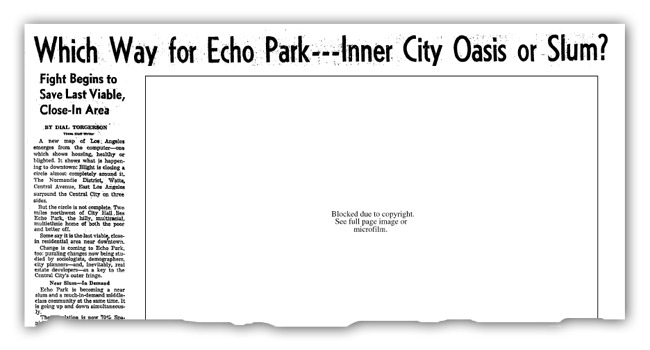Flashback Fridays – The Fate of Echo Park
Both Kelly and I (on separate occasions) dug up a rather interesting article from the L.A. Times circa 1971. The article, entitled “Which Way for Echo Park – Inner City Oasis or Slum?”, describes Echo Park at the dawn of the ’70s as:
…the hilly, multiracial, multiethnic home of both the poor and better off. Echo Park is becoming a near slum and a much-in-demand middle-class community at the same time. It is going up and down simultaneously. Newcomers from from poorer areas are crowding into substandard housing and youth gangs have become active. At the same time, there is a different influx: that of the middle class. Older couples who sold homes in distant suburbs and young marrieds with college degrees are seeking homes and rentals in the hills.
From what I’ve learned about Echo Park, it seems that it’s always been home to a mixture of different cultures and incomes. It’s interesting to see proof of this and to see an argument similar to the one happening today, taking place almost forty years ago. The same racial tensions that bubble beneath the surface of today’s arguments were there in the ’70s as well and, presumably, the ’60s. For example:
‘The rapidly changing ethnic composition of the Silver Lake-Echo Park communities will soon transform Echo Park into a Mexican-American barrio,’ said a UCLA study for the city’s new general plan. ‘We strongly urge that, via the process of community organizations and related efforts, steps be taken to avoid further ghettoization.’ Many long-time residents of Echo Park, members of its Latin community, object to experts’ blaming Latins as the bringers of the slum.
Eek! Yeah, I think an objection to that study is justified. The article also brings up some interesting bits about the cultural differences between certain residents of Echo Park. Some of these descriptions sound vaguely familiar…
The Hip community calls it “The Other End,” the other end of Sunset Blvd. from the Strip. Barefoot hippies buy food with food stamps in the same supermarket lines with young deputy public defenders with mod clothes and lavish mustaches. Chicano street types dress in a uniform of neat jeans (or overalls) and clean white T-shirts; they haven’t learned, as have their Anglo contemporaries in the suburbs, to believe that dirt is somehow revolutionary.
Read the full article here (PDF download).


You’ve made some really good points there. I looked on the web for more info about the issue and found most individuals will go along with your views on this web site.
Your style is very unique in comparison to other people I’ve read stuff from. Many thanks for posting when you have the opportunity, Guess I will just bookmark this page.